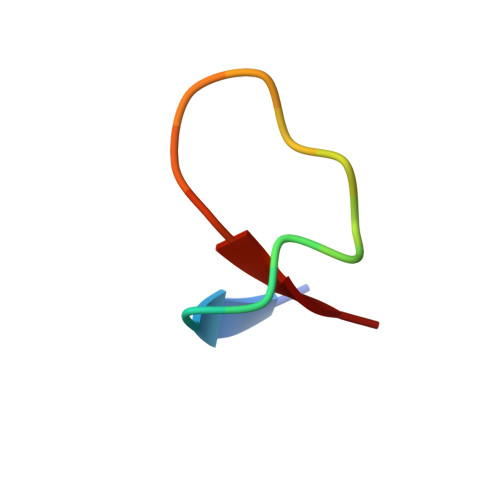General rules of fragmentation evidencing lasso structures in CID and ETD.
Jeanne Dit Fouque, K., Lavanant, H., Zirah, S., Hegemann, J.D., Fage, C.D., Marahiel, M.A., Rebuffat, S., Afonso, C.(2018) Analyst 143: 1157-1170
- PubMed: 29404537
- DOI: https://doi.org/10.1039/c7an02052j
- Primary Citation of Related Structures:
5OQZ - PubMed Abstract:
Lasso peptides constitute a structurally unique class of ribosomally synthesized and post-translationally modified peptides (RiPPs) characterized by a mechanically interlocked structure in which the C-terminal tail of the peptide is threaded and trapped within an N-terminal macrolactam ring. Tandem mass spectrometry using collision induced dissociation (CID) and electron capture dissociation (ECD) have shown previously different fragmentation patterns for capistruin, microcin J25 and their corresponding branched-cyclic forms in which the C-terminal tail is unthreaded. In order to develop general rules that unambiguously discriminate the lasso and branched-cyclic topologies, this report presents experimental evidence for a set of twenty-one lasso peptides analyzed by CID and electron transfer dissociation (ETD). CID experiments on lasso peptides specifically yielded mechanically interlocked species with associated b i and y j fragments. For class II lasso peptides, these lasso-specific fragments were observed only for peptides in which the loop, located above the macrolactam ring, was strictly longer than four amino acid residues. For class I and III lasso peptides, part of the C-terminal tail remains covalently linked to the macrolactam ring by disulfide bonds; associated b i and y j fragments therefore do not clearly constitute a signature of the lasso topology. ETD experiments of lasso peptides showed a significant increase of hydrogen migration events in the loop region when compared to their branched-cyclic topoisomers, leading to the formation of specific c i ˙/z' j fragments for all lasso peptides, regardless of their class and loop size. Our experiments enabled us to establish general rules for obtaining structural details from CID and ETD fragmentation patterns, obviating the need for structure determination by NMR or X-ray crystallography.
Organizational Affiliation:
Normandie Univ, UNIROUEN, INSA Rouen, CNRS, COBRA, 76000 Rouen, France. helene.lavanant@univ-rouen.fr.














